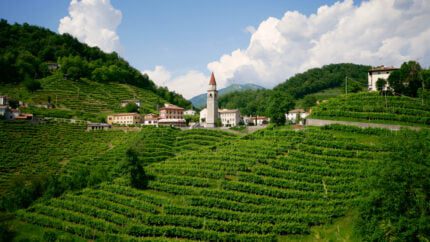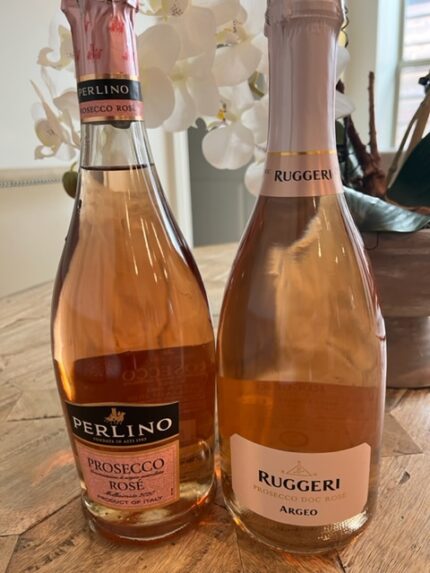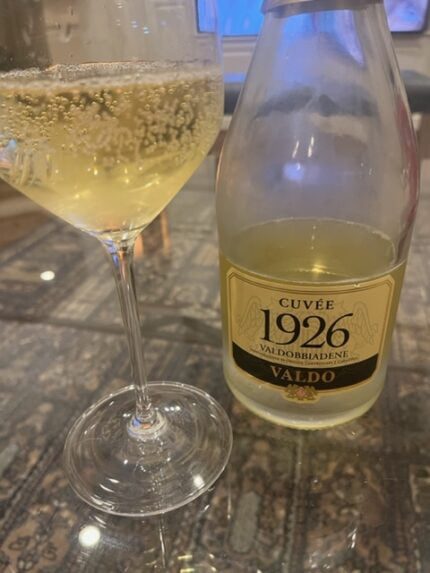It seems that overnight Prosecco has become a sensation in America. No longer relegated to what you mix in your mimosa, these wines have evolved from an obscure grocery shelf to one you seek out at the wine store.
There’s a reason – we now have much more accessibility to the better stuff. According to research from the Prosecco DOC Consortium, the value of sparkling wines imported to the US hit $519 million, which was a 19.1% increase on pre-pandemic levels in 2019. Prosecco DOC rose by volume to 25.5 million gallons – an increase of 44.3% on 2020 and 40.3% from 2019. The total export volume of Prosecco in 2019 was 17.6 million gallons.

Prosecco History
Prosecco is an Italian Denominazione di Origine Controllata (DOC), and Denominazione di Origine Controllata e Garantita (DOCG) produced in Northeastern Italy, in Veneto and Friuli-Venezia Giulia, between the Dolomites and the Adriatric Sea.
It’s named after the village of Prosecco, which is in the province of Trieste, Italy. Prosecco is made primarily from the Glera grape and no other region can use the name. Prosecco is made using the Charmat method where the second fermentation is in a pressurized tank. The climate, the soil and the winemaking tradition are the characteristics of the region.
The production area for Prosecco DOC (both traditional and Rosé) is in the territories of five provinces in the Veneto region (Treviso, Venice, Vicenza, Padua, Belluno) and 4 provinces in Friuli Venezia Giulia (Gorizia, Pordenone, Trieste and Udine).
In 1772, Francesco Maria Malvolti first referenced the Conegliano Valdobbiadene region and Prosecco, but it took until the 1930s for the boundaries to be outlined. Grapes are hand-picked and are known for lower yields and even though the DOC was introduced in 1969, only 15 communes produce them. I had a chance to cover the DOCG region a few years ago during a Wine Studio program and was always impressed with the quality to value ratio.

There are four categories of DOC prosecco — spumante, frizzante, tranquillo and rosé. Prior to August 2020, rosé was not an existing category because regulations did not allow red grapes to be used in vinification. With the change, the grapes were required to be exclusively Glera (between 85-90 percent) using Pinot Noir vinified in red (10-15 percent) and the Prosecco DOC Rosato Millesimato was established.
The bottles are also distinctive with a unique alphanumeric code on the bottle to prove authencity, a barcode and the DOC and made in Italy listed on the bottle.

I tried three different wines:
NV Ruggeri Argeo Prosecco Rosé
Notes of red fruit, jasmine, ginger, herbs, stone fruit and a nice minerality. It is a blend of 85 percent Glera and 15 percent Pinot Noir.
Ruggeri Winery
Established in 1950 by Giustino Bisol, this property and family have been making wine for centuries. Located in the Santo Stefano in Valdobbiadene, today the winery is run by Paolo Bisol and his children.
NV Perlino Prosecco Rosé Extra Dry Millesimato
This wine is made of 90% Glera with 10% Pinot Nero. I tasted notes of juicy strawberry, citrus, apricot, cherry and cranberry.
Perlino Winery
Perlino Winery has been operating since 1905 as winemakers and grape growers. They make sparkling wines, still wines and vermouth by several family generations.

NV Valdo Cuvée 1926 Valdobbiadene Superiore DOCG
Notes of apple, pear, stone fruit, pineapple and jasmine. It was balanced and tastes much more expensive than it is.
Valdo Winery
Founded in 1926 by the Societa Anonima Vini Superiori and purchased by the Bolla Family in 1938, Valdo is the oldest winery of Prosecco in Valdobbiadene. For 90 years, they have been dedicated to the vineyards and winemaking traditions.
With the expansion of prosecco, we happily have more access to better quality stuff. I suggest you look for a bottle with the DOC or the DOCG designation, go easy on your wallet and enjoy.



